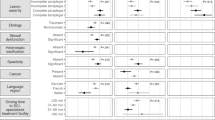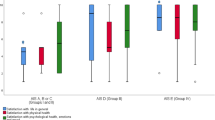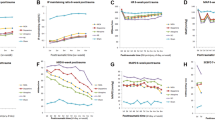Abstract
Study design:
Questionnaire-based survey study.
Objectives:
To evaluate the use of and the satisfaction with complementary and alternative medicine (CAM) techniques in patients with spinal cord injury (SCI).
Setting:
Rehabilitation Center, Switzerland.
Methods:
Between May and September 2014, all patients with chronic (>1 year) SCI attending the urologic outpatient clinic were asked to fill in a questionnaire regarding the use of CAM.
Results:
Of the 103 participants (66 men and 37 women), 73.8% stated that they have used some form of CAM since SCI, with acupuncture and homeopathy being the two techniques that were used most frequently (31% each). The most common indications for CAM use were pain and urinary tract infections (UTIs). CAM was used supplementarily rather than exclusively. Overall satisfaction (85.1%) as well as satisfaction rates for the different indications (pain: 85%; UTI: 90.5%) and for the most frequently used forms of CAM (homeopathy: 90.6%; acupuncture: 78.1%) were high.
Conclusion:
According to our data, there is a demand for adjunctive CAM procedures for the treatment of medical complications by persons with SCI. CAM led to high satisfaction levels. On the basis of these results, future research should systematically evaluate the therapeutic potential of the most popular CAM techniques, for example, acupuncture and homeopathy, for the treatment of secondary medical complications of SCI.
Similar content being viewed by others
Log in or create a free account to read this content
Gain free access to this article, as well as selected content from this journal and more on nature.com
or
References
van den Berg ME, Castellote JM, de Pedro-Cuesta J, Mahillo-Fernandez I . Survival after spinal cord injury: a systematic review. J Neurotrauma 2010; 27: 1517–1528.
Chiodo AE, Scelza WM, Kirshblum SC, Wuermser LA, Ho CH, Priebe MM . Spinal cord injury medicine. 5. Long-term medical issues and health maintenance. Arch Phys Med Rehabil 2007; 88: S76–S83.
Pannek J . Treatment of urinary tract infection in persons with spinal cord injury: guidelines, evidence, and clinical practice. A questionnaire-based survey and review of the literature. J Spinal Cord Med 2011; 34: 11–15.
D'Angelo R, Morreale A, Donadio V, Boriani S, Maraldi N, Plazzi G et al. Neuropathic pain following spinal cord injury: what we know about mechanisms,assessment and management. Eur Rev Med Pharmacol Sci 2013; 17: 3257–3261.
Pannek J, Pannek-Rademacher S, Jus MC, Jus MS . Usefulness of classical homoeopathy for the prevention of urinary tract infections in patients with neurogenic bladder dysfunction: a case series. Indian J Res Homoeopathy 2014; 8: 31–36.
Olsen SA . A review of complementary and alternative medicine (CAM) by people with multiple sclerosis. Occup Ther Int 2009; 16: 57–70.
Harirchian MH, Sahraian MA, Hosseinkhani A, Amirzargar N . Level of attitude toward complementary and alternative medicine among Iranian patients with multiple sclerosis. Iran J Neurol 2014; 13: 13–18.
Carlson MJ, Krahn G . Use of complementary and alternative medicine practitioners by people with physical disabilities: estimates from a National US Survey. Disabil Rehabil 2006; 28: 505–513.
Büssing A, Ostermann T, Heusser P, Matthiessen PF . Usage of alternative medical systems, acupuncture, homeopathy and anthroposophic medicine, by older German adults. Zhong Xi Yi Jie He Xue Bao 2011; 9: 847–856.
Johnston L . Paralyzed Veterans of America's Education Foundation Alternative, complementary, energy-based medicine for spinal cord injury. Acta Neurochir Suppl 2005; 93: 155–158.
Hendershot GE . Mobility limitations and complementary and alternative medicine: are people with disabilities more likely to pray? Am J Public Health 2003; 93: 1079–1080.
Posadzki P, Watson LK, Alotaibi A, Ernst E . Prevalence of use of complementary and alternative medicine (CAM) by patients/consumers in the UK: systematic review of surveys. Clin Med 2013; 13: 126–131.
Cardenas DD, Jensen MP . Treatments for chronic pain in persons with spinal cord injury: a survey study. J Spinal Cord Med 2006; 29: 109–117.
Heo I, Shin BC, Kim YD, Hwang EH, Han CW, Heo KH . Acupuncture for spinal cord injury and its complications: a systematic review and meta-analysis of randomized controlled trials. Evid Based Complement Alternat Med 2013; 2013: 364216.
Arienti C, Daccò S, Piccolo I, Redaelli T . Osteopathic manipulative treatment is effective on pain control associated to spinal cord injury. Spinal Cord 2011; 49: 515–519.
Jensen MP, Barber J, Romano JM, Hanley MA, Raichle KA, Molton IR et al. Effects of self-hypnosis training and EMG biofeedback relaxation training on chronic pain in persons with spinal-cord injury. Int J Clin Exp Hypn 2009; 57: 239–268.
Hess MJ, Hess PE, Sullivan MR, Nee M, Yalla SV . Evaluation of cranberry tablets for the prevention of urinary tract infections in spinal cord injured patients with neurogenic bladder. Spinal Cord 2008; 46: 622–626.
Lee BB, Haran MJ, Hunt LM, Simpson JM, Marial O, Rutkowski SB et al. Spinal-injured neuropathic bladder antisepsis (SINBA) trial. Spinal Cord 2007; 45: 542–550.
Thompson E, Hicks F . Intrathecal baclofen and homeopathy for the treatment of painful muscle spasms associated with malignant spinal cord compression. Palliat Med 1998; 12: 119–121.
Pannek J, Pannek-Rademacher S, Cachin-Jus M . Organ-preserving treatment of an epididymal abscess in a patient with spinal cord injury. Spinal Cord 2014; 52: S7–S8.
Author information
Authors and Affiliations
Corresponding author
Ethics declarations
Competing interests
The authors declare no conflict of interest.
Rights and permissions
About this article
Cite this article
Pannek, J., Pannek-Rademacher, S. & Wöllner, J. Use of complementary and alternative medicine in persons with spinal cord injury in Switzerland: a survey study. Spinal Cord 53, 569–572 (2015). https://doi.org/10.1038/sc.2015.21
Received:
Revised:
Accepted:
Published:
Issue date:
DOI: https://doi.org/10.1038/sc.2015.21
This article is cited by
-
Behandlung rezidivierender Harnwegsinfekte bei PatientInnen mit neurogener Blasenfunktionsstörung
Journal für Urologie und Urogynäkologie/Österreich (2022)
-
Behandlung rezidivierender Harnwegsinfekte bei PatientInnen mit neurogener Blasenfunktionsstörung
Urologie in der Praxis (2021)
-
Management of Chronic Bacteriuria in Neurogenic Bladders
Current Bladder Dysfunction Reports (2020)
-
Verlauf der neurogenen Blasenfunktionsstörung bei Patienten mit Rückenmarkschädigung unter klassisch homöopathischer Therapie
Der Urologe (2020)
-
Psychological distress and user experiences with health care provision in persons living with spinal cord injury for more than 20 years
Spinal Cord (2017)



